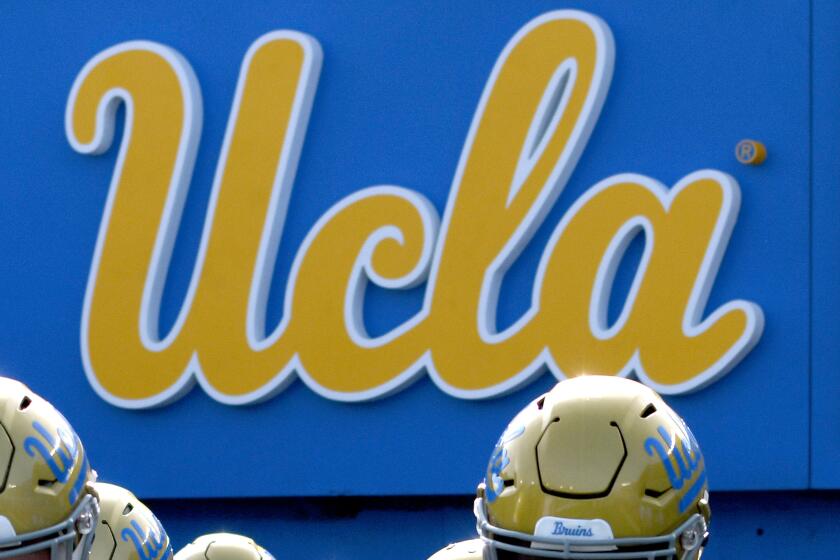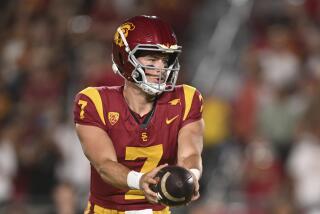Jayden Daniels and Kedon Slovis represent college football’s newest trend

Arizona State offensive coordinator Rob Likens searched far and wide last year, crisscrossing the country in search of a quarterback recruit who could come in and compete right away for a starting spot.
He was blown away by how many eligible candidates he found.
“Last year’s class was nice,” Likens said. “Absolutely.”
It wasn’t long ago that such a task would have felt futile. Perhaps as much as any position in football, quarterback required development. Conventional wisdom used to call for almost all signal callers to sit on the bench at first, believing they needed seasoning while awaiting their turn.
There were some exceptions, including Jared Goff starting in his first season at California in 2013. But they were few and far between.
“He was the rare guy to start [as a freshman],” said Likens, the receivers coach on Goff’s Golden Bears team in 2013. “Now you look up, there’s a new one everywhere.”
Indeed, freshman quarterbacks are suddenly on the rise. Like Darwinism on the gridiron, the organic evolution is causing the college football world to slowly adapt. Old quarterback rules are starting to go by the wayside. Natural selection is increasingly favoring the young.
“I think this is the new norm,” said Greg Biggins, a recruiting analyst for 247Sports who has been evaluating quarterback prospects from Southern California and beyond for the last 25 years. “I think we’re in that day and age where kids just, they want to play right now. That’s the goal.”
It wasn’t so long ago that UCLA was a helpless 1-5. Now, Chip Kelly’s Bruins have a chance to grab the Pac-12 South with a win over Utah.
During the first half of this decade, freshman quarterbacks were still something of a novelty. Only once between 2010-14 were there even five freshmen in Power Five conferences to lead their team in throws.
But since then, a new trend has developed. In 2015, eight primary Power Five freshman quarterbacks were their school’s top passer, a class highlighted by Lamar Jackson at Louisville, Josh Rosen at UCLA, and Drew Lock at Missouri. In 2016 and 2017, five more joined the group.
Last year’s class produced another nine. The last two national championship games have been won by freshman quarterbacks (Alabama’s Tua Tagovailoa in 2017 and Clemson’s Trevor Lawrence in 2018) as well.
This season, seven Power Five rookies are currently leading their teams in passing: Jayden Daniels at ASU, Kedon Slovis at USC, Sam Howell at North Carolina, Max Duggan at Texas Christian, Ryan Hilinski at South Carolina, Bo Nix at Auburn and Garrett Shrader at Mississippi State. Combined, that group has 94 touchdowns to 33 interceptions. Five of the seven have winning records.
At the Group of Five level, Central Florida’s Dillon Gabriel is ninth in the nation with 2,516 passing yards, while Boise State’s Hank Bachmeier (a Murrieta Valley product) has the Broncos off to a 7-1 start.
“Maybe it’s the year-round preparation, maybe it’s the seven-on-seven, maybe it’s just the way they prepare, but you’re seeing more freshmen ready to play now than I think ever before,” Biggins said. “Quarterbacks are just more advanced when they come in as true freshmen.”
USC and ASU, who will meet in Tempe on Saturday, have moved to the forefront of this trend.
For the second straight season, the Trojans are relying on a freshman under center in Slovis, who took over the starting job after JT Daniels (a freshman starter in 2018) suffered a season-ending injury in Week 1.
The Sun Devils, meanwhile, have relied on freshman and San Bernardino native Jayden Daniels from the start of the season. Daniels’ status for Saturday’s game is reportedly in doubt (an ASU official said, “Like all players, [Daniels] will be a game-day decision”), leaving open the possibility that fellow freshman Joey Yellen, a Mission Viejo High product, could make his first start.
Either way, the Pac-12 showdown will likely be the latest matchup of opposing freshman quarterbacks — an occurrence not nearly as uncommon as it used to be.
“You look up and a lot of these guys are starting, which is incredible,” Likens said. “Obviously, these last three years, football has changed like crazy. Before that, you didn’t see [this].”
Jayden Daniels and Slovis followed contrasting paths to first-year playing time.
An athletic and agile 6-foot-3, 175-pound dual-threat prospect, Daniels became the prototypical blue-chip recruit as a four-year starter at Cajon High. He was a finalist in the prestigious Elite 11 quarterback competition, ranked No. 3 at the position in the Class of 2019 by 247Sports, and announced his college decision with a staged ceremony that was streamed on YouTube.
After enrolling early at ASU this spring, he quickly emerged as the clear choice under center. He became the first freshman Week 1 starter at quarterback in program history and helped the Sun Devils to a 5-1 start that included two road wins over ranked opponents. Though Daniels has struggled during ASU’s current two-game skid, confidence from the Sun Devils’ coaching staff hasn’t wavered.
“You’re a freshman,” ASU coach Herm Edwards reminded Daniels. “You can look like that sometimes. You’re way ahead of where people anticipated.”
Slovis, on the other hand, flew under the radar.
A native of Scottsdale, Ariz., the strong-armed 6-2, 186-pound passer was passed over for the Elite 11 finals. Scholarships also barely trickled in at first, coming mostly from small-conference schools. USC was one of the first Power Five programs to extend an offer.
Slovis, who had NFL Hall of Fame quarterback Kurt Warner as one of his high school coaches, committed to the Trojans before the start of his senior high school season.

“I think by the time [these quarterbacks] are getting to college now, they’ve had the equivalent of what used to be a few years of college experience at running a fairly sophisticated offense,” said David Sedmak, Slovis’ head coach at Desert Mountain High, the same program current Carolina Panthers quarterback Kyle Allen came through.
“In Kedon’s case … Kurt ran what was probably an offense that was a little too complicated for the bulk of our players, but wasn’t too much for Kedon. Kedon benefited from being stretched like that.”
Slovis came to Los Angeles planning to be the backup, but capable of handling much more. He surprisingly earned the backup role entering the season, and has stepped into the Trojans’ Air Raid offense almost seamlessly since taking over full-time.
Among the seven starting Power Five freshman quarterbacks, only Howell has more touchdown passes than Slovis, who has 16 scores despite having missed most of two games in September with a concussion.
“The common denominator between both [Jayden Daniels and Slovis] is they came in really ready mentally,” Biggins said. “Both super smart, high football IQ guys.”
The ripple effects of such success stories are beginning to be felt. For every Daniels or Slovis, there is another batch of high schoolers behind them hoping to do the same — a growing collection of recruits focused on playing time first and foremost when evaluating schools.
“Maybe 10 years ago, [these quarterbacks] would just pick the best school for them,” Biggins said. “Now, they’re literally looking at schools that they can come into and play right away.”
The days of recruiting a top-level quarterback with the expectation they’ll ride the bench for a year or two are slowly starting to disappear. For those who don’t want to wait, the advent of the transfer portal has made switching schools easier than ever. Coaches are still trying to get comfortable with the new recruiting landscape.
Beau Gardner, an offensive lineman for St. Ignatius College Prep in San Francisco, announced Tuesday he is planning to attend UCLA as a long snapper.
“I think you’ve got to be honest,” said Likens, whose ASU program signed three quarterbacks in the 2019 class. “If you tell them everything they want to hear to get them here, and then they leave, you’re in a worse position than if you didn’t sign that kid in the first place.
“So you might as well just tell them the truth. That’s what I want to hear. If you have respect for a kid, you tell them all the information so that they can make a good, well-educated decision.”
It wasn’t long ago that such choices were rarely available to incoming college quarterbacks. Now, they’re beginning to dictate the entire directions of more and more programs each year.
“I think that’s what’s affecting recruiting,” Biggins said. “They don’t want to wait even a year.”
More to Read
Go beyond the scoreboard
Get the latest on L.A.'s teams in the daily Sports Report newsletter.
You may occasionally receive promotional content from the Los Angeles Times.









